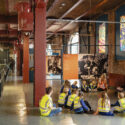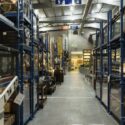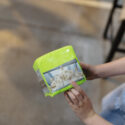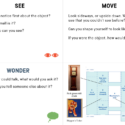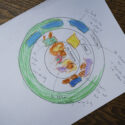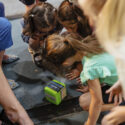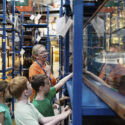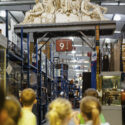See, move, wonder: supporting young children with low science capital to learn from science museum objects
Article DOI: https://dx.doi.org/10.15180/252305
Abstract
Museum visits by school groups contribute towards life-long science engagement. This is likely to be particularly true for young children who have low science capital. There is only limited research on how museums can support low science capital school groups to engage and learn, particularly in object-rich galleries. The current research addresses this gap. It considers how a simple resource supports playful learning in two object-rich galleries. The resource invites children to find objects and interact with the objects through observation, movement and wondering. Some 92 children (4–7 years) and 15 adults in seven school groups were observed using the resource and then subsequently interviewed. Findings show that encouraging children to search for objects, move in relation to objects and wonder about objects supports learning. Movement and gestures were central to how children experienced the objects as these embodied forms of cognition did not require specific understanding or vocabulary. These findings show that museums can support low science capital young children to learn from objects through a focus on bodily experiences. The theoretical implications of these findings include the value of embodied cognition theory in supporting object engagement and learning, particularly for young children with low science capital.
Keywords
early years, education, embodied cognition, gestural knowledge, play, science capital, Science Museum, science museums, science skills, STEM learning
Introduction
https://dx.doi.org/10.15180/Over recent years there has been a growing interest in how young children engage with and learn about science, technology, engineering and mathematics (STEM), within and beyond the classroom. There is an understanding that science experiences in the early years greatly influence perceptions and understanding of science in later years (Harris Helm et al, 2023). The UK government introduced the Early Years Foundation Stage (EYFS) for England in 2008, which sets standards for learning, development and care of children from birth to five years. The revised standards from 2017 and 2024 include a focus on science learning by encouraging children to explore their environments and consider differences amongst living things and objects.[1] It is widely acknowledged that trips to museums can enhance such learning, particularly for those children who are unlikely to visit museums with their families (Morentin and Guisasola, 2014). As part of EYFS experiences many schools offer museum visits to encourage young children’s learning, engagement and exploration.
Diversifying audiences
Early years audiences are important for science museums, such as to align with their mission to engage a wide range of people, including young children, with STEM. For example, the Science Museum Group (SMG) aims to inspire the next generation of scientists, inventors and engineers, and to encourage a society that celebrates STEM and the impact of STEM on our lives, now and in the future (SMG, 2022). Central to this work is a society in which all people feel that STEM is ‘for them’ and to encourage more diverse audiences to engage with STEM at the SMG sites. Of particular importance are under-represented visitor groups, such as people with low science capital. Science capital refers to specialist knowledge, skills, qualifications, interests and social connections related to science (Archer et al, 2012). Supporting visitor groups with low science capital to visit museums and engage with STEM matters because science is a valuable resource in our societies (Dawson, 2016) and because museums are useful places to enjoy and learn about science (Falk et al, 2007). Visits by school groups are a unique opportunity to engage children with low science capital as almost all children attend school, and their STEM participation can therefore be established regardless of their existing science capital or that of their families.
Resources to support learning in museums
Museums generally actively try to support learning through various resources, such as labels and activities. The increased consideration of young children as active learners in museums has amplified the importance of creating learning resources suitable for young children. Objects play an important role in museum learning by offering tangible experiences and opportunities for engagement and conversations (Novak et al, 2020), suggesting their importance for early years learning. However, there is only very limited research on early years children in museums that focuses on learning, particularly with respect to object-based learning (Flewitt et al, 2019).
The research outlined in this paper is based on the Second Phase of a project entitled Early Years and Learning. The project aims to understand how young children can be supported to engage and learn from museum objects related to STEM. The project focuses on object-rich galleries that are not purposefully aimed at early years’ audiences. The Second Phase runs from January 2023 to December 2025, and centres explicitly on young children with low science capital. Prior publications from research in Phase 1 highlight the importance of young children’s agency to support learning from objects (Manyukhina et al, 2023), as well as the importance of encouraging young children’s physical play on gallery to create familiarity and context (Haywood et al, 2023). The research documented here builds on these findings. It took place at The Science and Industry Museum (SIM) in Manchester and The National Railway Museum (NRM) in York, and addresses the following research question: How can young children with low science capital in school groups be supported to engage with and learn from science museum objects?
Prior research and conceptual framework
This study is informed by prior research and theory on embodied cognition, as well as conceptualisations of science capital.
Embodied cognition: movement and gesture shape learning
Science is a dynamic activity involving the brain, body and the world around us (Kuhn, 1993). Framing science as ‘doing’ implies the importance of considering movement and gesture in learning science. Gestures refer to spontaneous hand movements that often occur in unison with speech. Children and adults are often unaware of their gesturing, and even gesture if the listener cannot see them. For example, people often gesture if they are on a phone call without video (Manches and Mitchell, 2023). The way that children and adults think and learn is inseparably linked to body-based experiences. Thinking and learning are ‘embodied’ in that they are grounded in bodily experiences. Embodied cognition is the theory that the mind not only influences and directs the body, but also that the body influences and directs the mind (Ghazali-Mohammed, 2018). Meaningful movement and gesture can directly shape learning. Learning can therefore be supported by encouraging children to use movement and gestures.
There is evidence that gestures play a causal and lasting role in children’s STEM learning processes. For example, Cook et al (2008) instructed eight and nine-year-old children in using hand gestures while learning a new mathematical concept. Cook et al found that this instruction helped children to understand and retain the new mathematical concept more than when children were not instructed to gesture. This was the case even for children who did not spontaneously use gesture during mathematical learning prior to instruction. In addition, children who were instructed to verbally show the new concept did not demonstrate the same level of lasting understanding of the new concept as children who were asked to show the new concept with their hands. It therefore appears that gesturing is causally linked to learning, and that children’s learning can be improved by encouraging hand movements. Gesturing provides learners with alternative, embodied ways of representing new ideas that seem to directly support learning. Expressing information through gesturing could facilitate encoding in long-term memory by producing stronger and more robust memory traces compared to expressing information only in speech. This might be due to gesturing involving larger motor movements or because of the potential for action-based, bodily encoding.
Movement and gesture dominate children's learning
Embodied cognition research highlights the importance of movement and gesture for how we communicate our understanding. We often intuitively gesture when we explain ideas, and therefore gestures provide insights into the way that we think and understand the world. Gestures can demonstrate what children know, sometimes before they are able to communicate their knowledge verbally. Gestures are not only an important causal part of the learning process, but also part of how children express and elaborate on what they have learnt.
Thomas Jha et al (2021) examined how nursery school-aged children (mean age = 4.6 years) spontaneously used gesture during interactions at a water table that involved various pumps, containers and tubes to play in water. Thomas Jha et al found that children used gestures to talk about what they experienced at the water table. Children often substituted verbally unknown referents or descriptions with gesture, such as a pushing or pulling movement to denote a pump. This allowed children to demonstrate what they understood with minimal use of ‘science’ vocabulary.
Jha et al also found that children’s gestures directly supported their learning of STEM concepts related to the water play. For example, children used hand gestures to show how different ways of manipulating the pump resulted in different water movement. These gestures demonstrate children’s observation and hypothesis skills, and suggest an understanding of causality. Children’s sensorimotor experiences at the water table shaped their subsequent hand gestures, which in turn shaped their scientific meaning-making. Children’s gestures provided an ‘embodied toolkit’ for thinking and communicating that supported the link between action and abstraction.
Embodied science learning in museums
Insights gained through embodied cognition theory and research have sparked interest in supporting young children’s STEM learning through sensorimotor experiences in museums. The Move2Learn project is a multi-site international collaboration of informal science educators and learning science researchers across the UK and US, of which the SMG is a member. The project aspires to advance understanding on the role of embodied cognition in young children’s learning about science in informal settings.[2]
This project investigates how interactive museum exhibits can be designed to help young children express, communicate and develop scientific thinking through movement. The project’s focus on embodied cognition includes the key principle that the body plays a significant role in cognitive processes. By including physical activities in the learning process, bodily movements and senses influence cognitive thought processes. Manches and Mitchell (2023) note three key principles for museum practice that emerged from the project: (1) Recognise that children often express their understanding through movement and gestures rather than just words; (2) Encourage movement and gestures that make STEM more meaningful to children by linking their existing experiences to scientific concepts, ideas and language; (3) Communicate STEM in various ways that involve movement and gesture. Overall, embodied cognition provides insights into how museums can support young children’s learning by explicitly encouraging movement and gesture as an interpretation approach, as well as realising that young children’s movement and gesture provides evidence of their science learning.
Science capital
This paper focuses explicitly on young children with low science capital. Science capital is a form of cultural capital that relates to science, such as specialist knowledge, skills, qualifications, interests and social connections (Archer et al, 2012). Cultural capital refers to material and symbolic goods that can help to achieve social mobility for individuals if these goods are recognised by others. Cultural capital can be acquired through various means, an often-cited example being individuals gaining capital through educational qualifications that are valued in a certain field (Bourdieu and Passeron, 1990). Science capital encompasses a person’s familiarity with science, their understanding of how science works, and their ability to apply scientific knowledge to real-world situations. Science capital is not only about formal education in science; it also includes experiences, attitudes and cultural factors that shape a person’s relationship with science. Science capital can, for example, help individuals or groups navigate complex scientific writing, understand routes into a science career or follow hobbies related to science.
Visitors with low science capital are under-represented in museums. There are many barriers to visits, including costs, distance, and a sense that museums are not ‘for them’ (Dawson, 2016). Research at the Science Museum in London shows how families with low science capital often enjoy their visits, but also feel disoriented and disconnected. For example, adults visiting with children found it difficult to navigate the layout of the Museum, and were often unable to comprehend the language used, such as the use of the terms ‘objects’ and ‘statues’. The general atmosphere of museums was one in which these visitors had fun, but from which they were unable to derive relevance for their lives or educational benefits (Haywood and Moussouri, 2017).
There is a connection between theory and research on science capital and embodied cognition. Both recognise the importance of experiences and interactions in shaping cognitive processes and learning. Work on children’s attitudes towards science emphasises the importance of eliciting their knowledge and experiences related to science, and linking these to canonical science content (DeWitt et al, 2013). Using the lens of embodied cognition speaks to this notion by foregrounding movement to engage with science. Embodied cognition places the child at the centre of science learning and supports them in meaning-making through reflection and communication of their experiences (Thomas Jha and Price, 2022). The lens of learning as embodied cognition is therefore particularly relevant for young children who do not have the vocabulary, understanding and science knowledge often perceived necessary to visit museums.
Method: outline of galleries and learning resource
Textiles Gallery at the Science and Industry Museum (SIM)
The Textiles Gallery at SIM tells the story of the people, places and products that made Manchester the international centre of the world’s cotton industry in the nineteenth century and transformed the city into an urban metropolis. The gallery also paints a picture of the continuing legacy of the cotton industry in the city today. There is a high object density in the gallery, with a large selection of different objects varying in size, interactivity, materiality and display. The range of objects include innovations, such as an original Richard Arkwright Water Frame, which is one of the machines that kickstarted the Industrial Revolution. The gallery also includes surprising, everyday objects, such as a pair of child-sized clogs from Charter Street Ragged School. The school was a local charity that helped some of Manchester’s poorest inhabitants (see Figure 1).
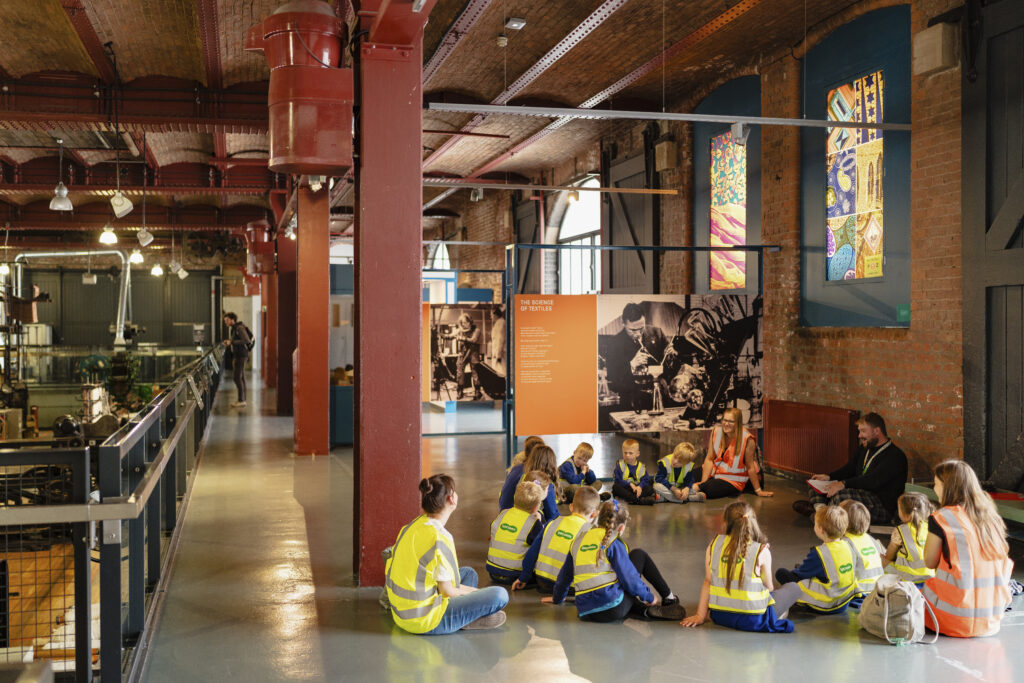
The North Shed at the National Railway Museum (NRM)
Previously known as ‘The Warehouse’, the North Shed is one of the Museum’s most popular areas. It is the third largest physical visitor area after the Great Hall and the Station Hall, and is home to thousands of smaller railway items, such as locomotive nameplates, and station signs and statues. These smaller objects are primarily located in metal shelving reaching from floor to ceiling. Some objects are placed behind glass, while other items are presented without glass casings. All objects have fairly short interpretive labels, focused mainly on the object’s name and date (see Figure 2).

While the Textiles Gallery and the North Shed are recommended for all ages, they are not specifically designed for early years children. The galleries were chosen for testing the resource due to their high object density. With a large selection of different objects varying in size, interactivity, materiality and display they provide many ways to fulfil the themes of the research.
Exploration Cubes resource
Exploration Cubes is a self-led resource comprised of a game with an oversized die and prompting questions provided on cards. The resource aims to provide an enjoyable experience and learning opportunity for children in school, community and family groups. The die has photos of four different objects that are on display in either the Textiles Gallery or the North Shed – depending on the location of the activity. On the fifth side of the die participants are asked to ‘roll again’, and on the sixth side of the die participants are asked to ‘choose any object you like’ (see Figure 3 for the die used at NRM).
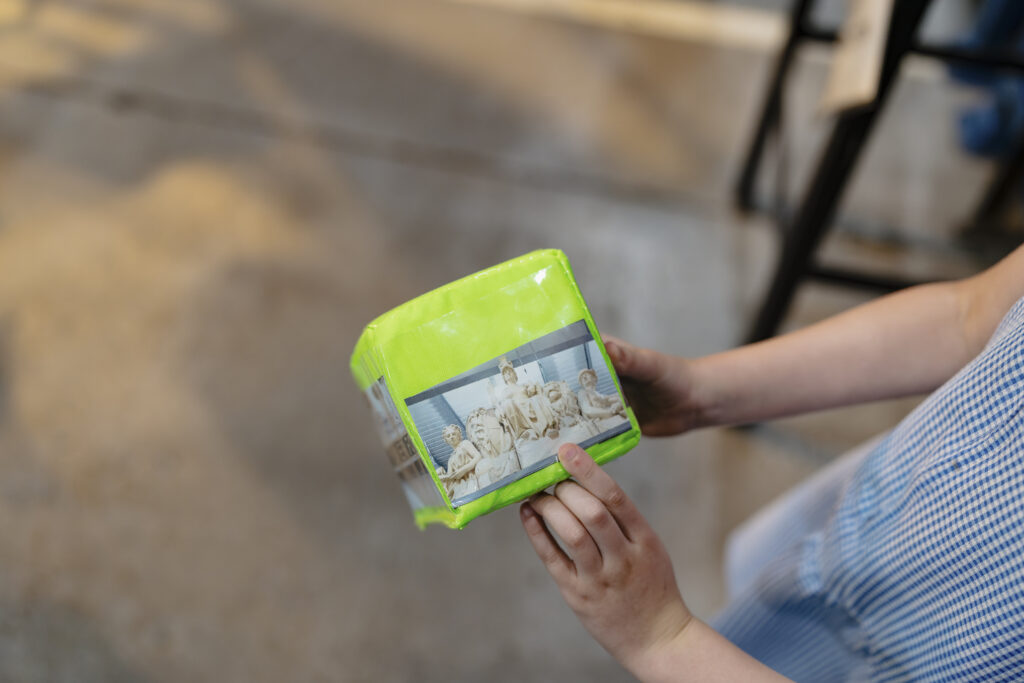
Featured objects from the Textiles Gallery are:
- Condensing Tube, which is a piece of laboratory glassware used to condense substances by allowing vapour to pass through a confined space.
- Park Green Mill Clock, which shows two clocks, one with ‘mill time’ and one with real time.[3]
- Spinning Mule, made in 1927 to spin stronger, finer yarn in great quantities.[4]
- Shipper’s Ticket, with tiger image, which is a textile export label attached to bolts of cloth or yarn to help make products recognisable to customers.
Featured objects from the North Shed are:
- Silver Fox Locomotive Plaque,[5] which was featured on the London & North Eastern Railway from A4 Class 60017. It was built in December 1935 and withdrawn in October 1963.
- Britannia with Supporters,[6] which is a large soft stone statue sculpted by John Thomas in 1849. It was displayed at Euston Station from 1849–1986.
- SS Arnhem, which is a model of the luxury ship built in 1946 that served Harwich–Hook of Holland.
- Cheeseburger Packaging[7], which is the packaging for the last microwaved burger served on Great North Eastern Railway on 31 May 1999. For more information, see Beefburger packet in presentation case
The objects were selected based on prior research that provides insights into objects that young children are particularly attracted to at the Science Museum in London (Flewitt et al, 2019).
To engage with Exploration Cubes, children are asked to roll the die to determine an object on gallery. Accompanying adults are asked to read prompting questions about the object that are given to them on cards. The prompting questions are grouped into ‘see’, ‘move’ and ‘wonder’ (see Figure 4 and Figure 5).
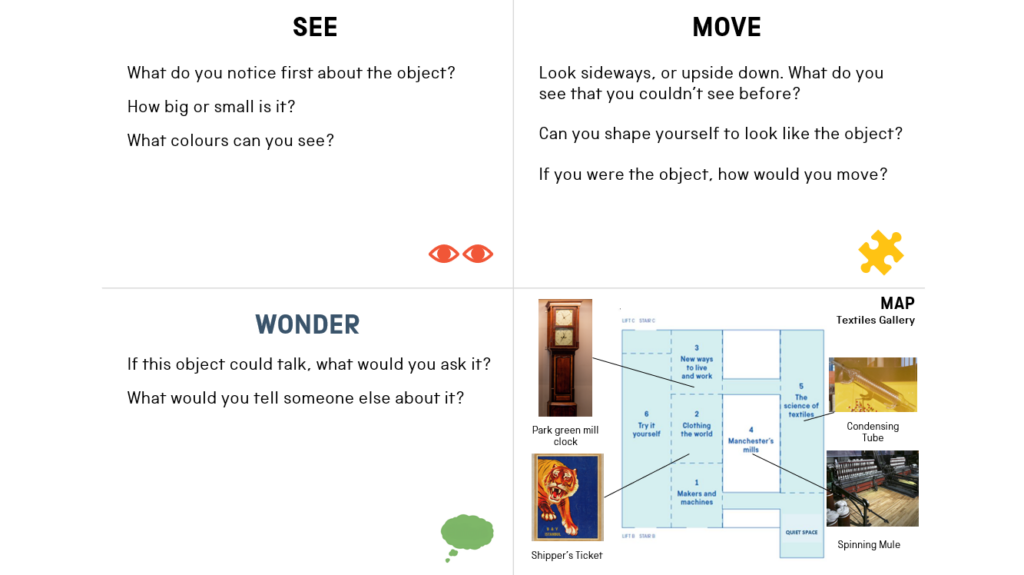
These prompting questions are inspired by and adapted from a ‘thinking routine’ developed by the Harvard Graduate School of Education that encourages thoughts aligned with: ‘I see…, I think…, I wonder….’[8] The ‘thinking routine’ encourages students to make careful observations and thoughtful interpretations by stimulating curiosity and setting the stage for inquiry.
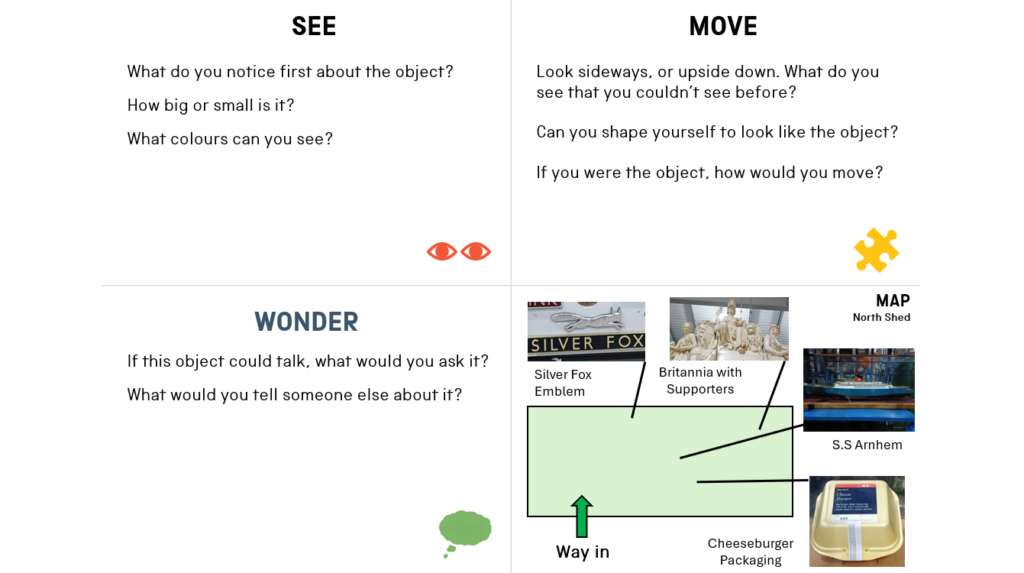
Overall, Exploration Cubes is relatively cheap, requires few supplies and could be implemented and removed without disrupting the experience for visitors without young children.
Participants
A total of 92 young children and 15 adults in seven school groups took part in the research (see Table 1 below). This number of participants allowed for the collection and analysis of rich, meaningful data necessary to examine young children’s experiences and use of Exploration Cubes. As the resource is innovative and untested with low science capital young children, it was important to ensure the gathering of in-depth insights from the perspective of young children.
Young children with low science capital were recruited. Measuring science capital is challenging and there is a consensus across the literature that science capital cannot usually be measured quickly or quantitatively, such as through a short ‘exit poll’ (Archer et al, 2015). There is no established theory or standardised assessment to capture young children’s attitudes towards, experiences and self-beliefs in science and science careers (Jones et al, 2022). However, there is a consensus across the literature that people, including adults and children, living in areas of high socio-economic deprivation typically have low science capital. This is because they have less access to STEM engagement opportunities (e.g., Archer et al, 2015). The research presented in this paper built on these findings from the literature, and acknowledges the challenges in measuring science capital, particularly for early years children. School groups from areas local to SIM and NRM that experience high levels of socio-economic disadvantage were invited to take part in the research.
Table 1: Research participants
| Location
|
Number of children and adults in school groups
|
| Textiles Gallery at SIM
|
52 children (28 girls and 24 boys) with age ranges 4–5 years
9 adults (5 school groups)
|
| North Shed at NRM
|
40 children (22 girls and 18 boys) with age ranges 6–7 years
6 adults (2 school groups) |
Data collection and analysis
Data collection took place between January–July 2024 in the Textiles Gallery at SIM and the North Shed at NRM. The school groups were split into smaller groups of around eight children supervised by one or two adults, usually one teacher and one teaching assistant or parent. All children and accompanying adults were assured that there were no right or wrong answers, and that they were the ‘experts’ whose opinions the relevant museum (SIM or NRM) was interested in most. Verbal consent from children and adults to take part in the testing was obtained. Data collection involved observation, subsequent semi-structured interviews and ‘concentric circles’ (see example provided later) to gain insights into young children’s and adults’ views and experiences of the Exploration Cubes resource.
Detailed observation notes were taken during participants’ interaction with Exploration Cubes. These notes were guided by a previously developed observation sheet that aimed to capture naturally occurring behaviours, gestures and talk of adults and children. The observation sheet included a focus on:
- General mood of children and adults
- Involvement in the activity of children and adults
- Signs of playfulness
- Conversations and questions around the activities or objects
- Signs of seeking out more information
- Barriers to engagement and learning
Semi-structured interviews took place after young children’s and their accompanying adults’ engagement with Exploration Cubes. The interviews lasted between 5–10 minutes and involved questions that focused on:
- First impressions of the resource
- Aspects of the resource that they particularly liked
- Aspects of the resource that they found confusing or disliked
- Understanding of the purpose of the resource
- Interest in and engagement with the object/objects on gallery
The interview guides directly asked children for their views and experiences in a playful manner. Providing additional time, considering children’s use of gestures and movement, and embedding questions and opportunities for young children to reflect on their experiences and views was used to gain deeper, additional insights directly from young children (e.g., see Hunleth, 2011; Punch, 2002).
‘Concentric circles’ encouraged children to draw or write in the middle of a sheet of paper what they liked most from their experience, and towards the outside what they did not like as much. These circles provided an age-appropriate and simple tool for young children to express their views on the resource, and served as a prompt for interview questions (see Figure 6 for an example of a ‘concentric circle’).
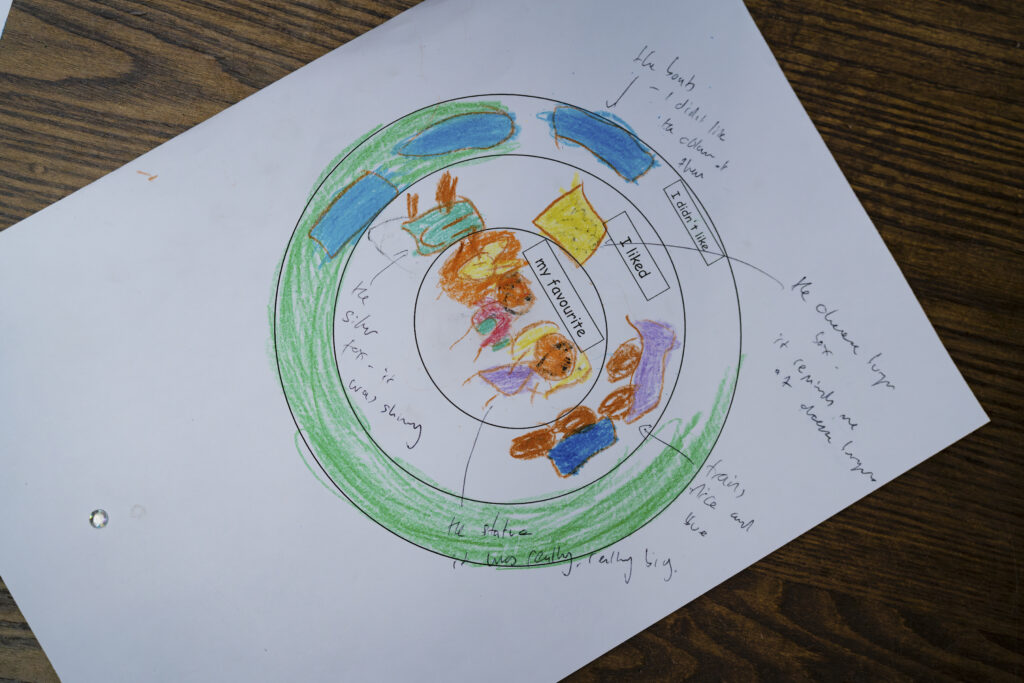
The data was analysed qualitatively using thematic analysis (Braun and Clarke, 2006; Merriam, 1998) that reflects data analysis approaches used in prior research that considers young children’s learning in museums (e.g., Manyukhina et al, 2023). The analysis involved: (1) Initial coding to define aspects linked to the research questions by bearing in mind the noted prior research on learning and science capital; (2) Grouping codes into higher-order themes; (3) Further coding based on emerging codes and themes; (4) Refining codes and themes; and (5) Re-examining and checking codes and themes. This approach ensured that in-depth insights from the perspectives and lived experiences of young children and their accompanying adults were gained.
Results and discussion
The resource provided a focus for the gallery visit that encouraged young children and their accompanying adults to become engaged with objects on gallery, to talk about objects and to learn from objects. The die and the three categories of prompts (‘see’, ‘move’ and ‘wonder’) provided a useful framing of children’s experiences that supported initial object engagement, on–gallery learning and communication of learning, as well as extending learning beyond the museum space.
Rolling the die and searching for objects is inherently understood and playful
All children used the Exploration Cubes resource with enjoyment and enthusiasm. Most children and their accompanying adults used the resource in the intended manner: rolling the die, searching for and finding the relevant object on gallery, and then using the ‘see’, ‘move’ and ‘wonder’ prompts.
Rolling the die and looking for something was inherently understood and recognised as playful by children and adults. Children were keen to roll the die, with children in the school groups often raising their hands to volunteer. Adults generally explicitly selected a child to roll the die. Children who were selected showed delight, and those children who were not selected often clapped and cheered in anticipation while the die was being rolled. Once the die had landed, children peered over it to see and identify the image of the object. This peering was generally associated with a significant amount of curiosity and talk related to the image of the object. Children used teamwork to speculate what the object might be, where it might be on gallery and often also exhibited an emotional reaction, such as noting “ohhh” in an excited manner. Adults at times helped children identify the image that the die had landed on. For example, several children initially identified the image of the Cheeseburger Packaging on the die at NRM as an egg carton. In these instances, teachers asked children to take another look at the image on the die and to think about another type of food packaging that might look similar to an egg carton, but that contains another type of food. Children were then able to correctly identify the image as being of a Cheeseburger Packaging, often comparing cheeseburgers to eggs as a meal and stating their preferences (see Figure 7 for an example of children peering at the die at NRM).
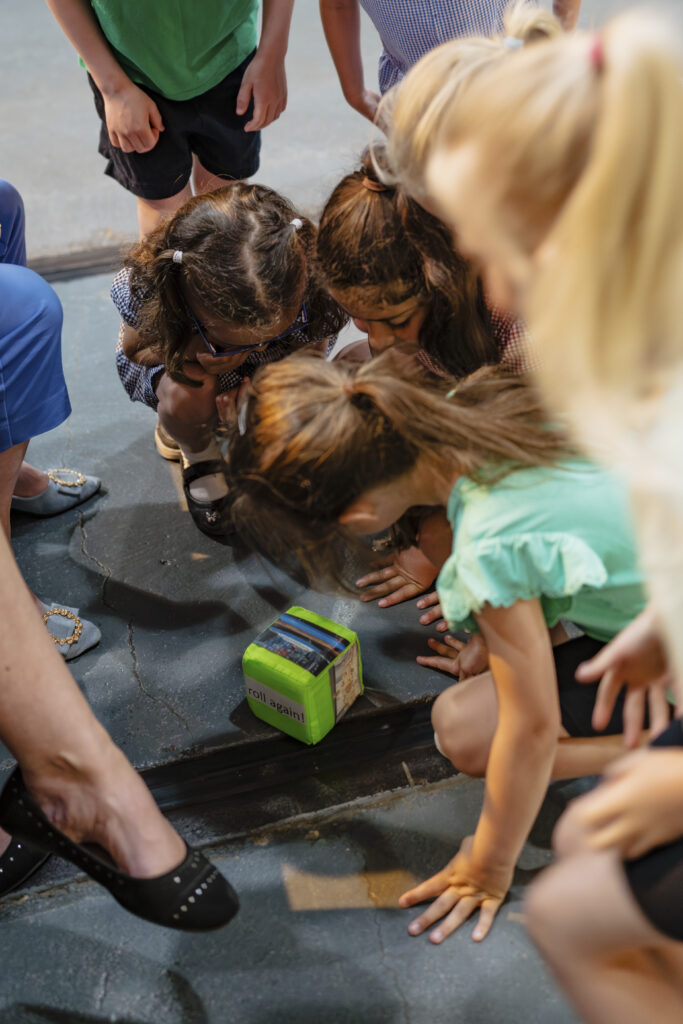
Teachers could not name all object images on the die. Notably, teachers were generally not able to name the images of the Condensing Tube or the Spinning Mule at SIM. This did not interfere or dampen children’s excitement in searching for the objects, nor were teachers generally particularly flustered or disconcerted when they could not name images of objects on the die. Consider, for example, how a school group of four- and five-year-olds and their teacher visiting the Textiles Gallery at SIM rolled the die and located the Condensing Tube (see Vignette 1).
Vignette 1:
The teacher asked the children if anyone wanted to roll the die. In response, almost all children excitedly raised their hands, and the teacher selected a child called Levi.[9] Levi’s classmates watched, and many clapped their hands while he rolled the die. When the die landed on the Condensing Tube image, the children peered over the die and looked closely at the image. Levi asked the teacher: “What’s that?” In response, the teacher also peered over the image and shrugged his shoulders, noting: “Shall we go and find it?” The children nodded and started walking across the gallery while peering into the object displays in search of the Condensing Tube. They stopped at several objects and talked about whether this was the relevant object. For example, the group stopped at the Spinning Mule Cops, which are cones made of twisted cotton. At this object, one child asked: “I think this looks a bit like it, but it’s not what we’re looking for. It’s [the Condensing Tube] made of glass.” Once they found the Condensing Tube, the children cheered in excitement. The teacher stated: “Oh, let’s look at this one!”
Across all school groups, once the image of the object on the die had been looked at and often briefly discussed, children walked around the gallery to locate the object, generally excitedly talking about their search. Adults joined the search, supporting children to look carefully in all directions, to collaborate with other children and to communicate what they saw. Searching for the object on gallery took a varied amount of time. Sometimes children almost immediately located the object, often because they had already seen it on gallery. At other times locating the object took up to ten minutes. In almost all instances children enjoyed the search. Longer object searching was often associated with brief mentions of other objects, or with comparing on-gallery objects to the image on the die, such as noted in Vignette 1.
During the activity and in their comments while completing the ‘concentric circles’, children often described searching for objects as a “treasure hunt.” In this way children likened the search to an activity that they are familiar with and that they enjoy. For example, after engaging with the resource at NRM, seven-year-old Aidan noted: “It was like a treasure hunt to find things in the museum… The treasures are all the things [objects]. We got to find them. It was fun.” Similarly, teachers noted that searching for the objects on gallery was an activity that children found fun and engaging. For example, one teacher visiting NRM with a school group noted: “I think searching for things [objects] is very entertaining for children. It’s a common childhood game. So here [at the museum] they immediately engaged with it.”
‘See’ prompts support initial object engagement
The ‘see’ prompts were used by almost all the young children and their accompanying adults. Generally, adults used the ‘see’ prompts as soon as children had located the object. Adults sometimes read aloud the exact wording of one or more of the ‘see’ prompts, such as: ‘What do you notice first about the object?’ Adults also often re-phrased one or more of the ‘see’ prompts for their children, such as re-phrasing ‘How big or small is it?’ as ‘Do you think it’s big? Or do you think it’s small?’. In interviews adults stated that re-phrasing helped them make the prompts directly relevant to their children or easier to understand – based on teachers’ knowledge of their school groups’ current interests. Children responded to the prompts by noting their observations of the object, such as stating its colour. In addition, children’s responses included their own experiences and interests. These responses to the ‘see’ prompts supported initial engagement with the object. Consider, for example, how a school group of six- and seven-year-olds and their teacher visiting the North Shed at NRM used the ‘see’ prompts (see Vignette 2). (See Figure 8 for an example of children and their teacher looking at the SS Arnhem).
Vignette 2:
After a brief object search, three children located the SS Arnhem on gallery – the object that the roll of the die had directed them to. The children shouted loudly and excitedly: “Here it is! Come over here! It’s here!” The other children and the teacher joined them. The teacher glanced at the prompts and asked: “Is it bigger or smaller than you thought?” Several children responded: “Bigger!” The children all looked at the ship. Then one child noted: “The real ship is big, but the one here is small.” Another child responded: “It’s like a toy of the real thing. It’s a big ship, but this one’s a small toy of how it looks like in real.” All children and the teacher peered into the object case at the ship and continued to talk about its size in relation to the real ship.
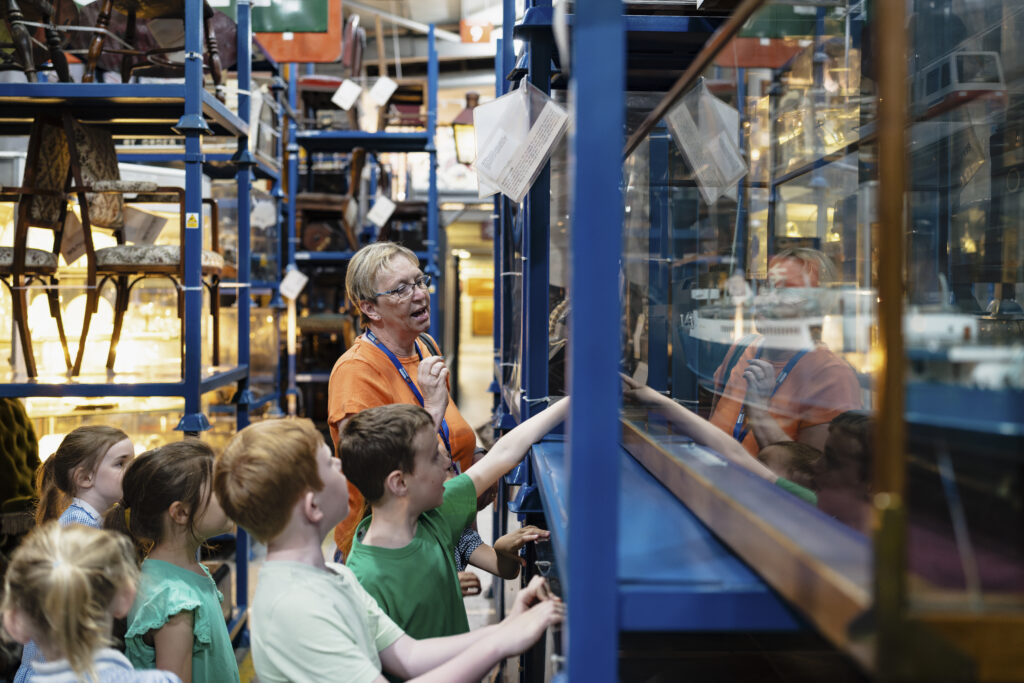
These kinds of interactions were common and show how the ‘see’ prompts supported initial engagement with objects on gallery. Use of the ‘see’ prompt meant that groups remained at the object for at least a short duration of time. It encouraged them to look closely at the object and to talk about it, rather than to immediately roll the die again and search for a new object. Children and adults understood the ‘see’ prompts as a cue to discuss and comment on the object that they had located. Teachers were confident in asking children simple questions based on the ‘see’ prompts once the object was located. These findings can be explained by the ‘see’ prompts being fairly simple to read out, rephrase and use as an inspiration for similar questions based on looking at the object. The prompts required no scientific language or understanding, even for objects that children and adults were unfamiliar with, such as the Condensing Tube. To use the prompt successfully and confidently, a high level of science capital was not required. The children and adults in this research with low science capital were immediately assertive in using the ‘see’ prompt. The prompt provided an accessible start to engaging with the object as the prompt provided links to young children’s and adults’ existing abilities, interests and knowledge.
In interviews with adults after their use of the resource, they often noted that the ‘see’ prompts were the easiest to use as they required children to simply look at the object. This initial engagement was seen to be conducive to further questions using the ‘move’ and ‘wonder’ prompts. Teachers also often noted that the initial engagement associated with the ‘see’ prompts encouraged children to ask their own questions and to comment on the object – an assertion that was confirmed during observation of children and their accompanying adults using the resource. For example, one teacher who visited NRM with a group of six- and seven-year-olds stated: “I liked the ‘see’ prompts because they were easiest… The children just look at the object, they can all answer the prompts, they will all have something to say… Then we can move on to the other prompts because the children are intrigued and already looking at the object… They’ll also be keen to ask their own questions and talk about the object.”
‘Move’ prompts support learning and communication of learning
The ‘move’ prompts invited young children and their accompanying adults to engage with objects in a creative manner that supported their learning and communication of learning. Many school groups used the ‘move’ prompts. Those school groups who did not use the ‘move’ prompts were mostly engaged in using the ‘see’ prompts for a long time and then moved on to the ‘wonder’ prompts. For school groups who used the ‘move’ prompts, these prompts were highly successful as they provided unique support for young children’s learning and their communication of learning.
School groups generally used the ‘move’ prompts by an adult reading out or rephrasing a ‘move’ prompt, after previously having used the ‘see’ prompts. For example, adults read out the prompt ‘If you were the object how would you move?’ In response to the ‘move’ prompts children often immediately engaged in movement and gestures, which was often associated with further questions and comments by the adults.
Movement and gestures support learning
Children’s movement and gestures were lively and light-hearted, with children often moving in an enthusiastic manner with exaggerated, comical gestures and associated sounds. Children frequently engaged in movement and gestures together with the other children in their group. Adults mostly watched and responded to the movement and gestures in a playful way, such as by clapping, laughing and smiling. Adults then often commented and asked questions related to the movement and gestures that focused on children’s experiences related to the object, rather than the object as such. Children often responded through further movement and gestures, and generally with associated verbal commentary. These interactions show how children’s prior experiences and understanding are embedded in their movement and gestures, and how children’s movement and gestures support their understanding of the object. Children used movement and gestures to engage with the object from their perspective, in a way that included and built on their existing capacities. Children were directing and shaping their learning through movement and gestures. Consider, for example, a school group of five- and six-year-old children engaging with the Spinning Mule at SIM.
Vignette 3:
A group of around ten children approached the Spinning Mule with their teacher. The teacher adapted a ‘move’ prompt to ask: “Can you make yourself look like the Spinning Mule? How might you look?” Six-year-old Safiya placed her hands over her head. The teacher laughed and some children copied Safiya’s gesture. The teacher then asked the school group: “How might it move?” Several pupils spun around and laughed. Safiya also turned her hands, then twisted her arms to indicate that she cannot turn her hands any further, and stated: “Oh! Ouch! I can’t anymore.” There was a lot of laughter, and the group looked at the Spinning Mule again.
The ‘move’ prompts supported these kinds of interactions with objects because they provided an explicit invitation for children to lead the experience, and because they encouraged a playful physical interaction related to the object that focused on children’s lived experiences rather than canonical science content. Adults saw the ‘move’ prompts as supporting learning that focuses on children’s interests, rather than on learning that focuses on knowledge transmission. For example, the teacher accompanying Safiya and her class stated: “When the children can move around, they are really in their element, they basically learn by themselves. I don’t need to tell them how the Spinning Mule might spin. They spun around and understood.”
Existing research on the Early Years and Learning project shows that young children often display movement, gestures and other physical activity to show engagement, interest and pleasure (Haywood et al, 2023). Moreover, these physical interactions support and are an expression of children’s agency and choice (Manyukhina et al, 2023). The current research shows how movement and gestures based on children’s agency and choice allow children to tap into their existing knowledge and understanding related to objects. Bodily experiences were central to how the young children experienced the objects, and how the objects related to learning. Through movement and gestures children gained an understanding of science objects that is based on their lived experiences. In the example above, Safiya used movement to express her understanding of how the Spinning Mule turns. Her hand gestures supported and demonstrated learning about the mechanical principles governing the object’s movements. Object engagement and learning in museums that is based on children’s experiences, such as expressed through movement and gestures, does not require high levels of science capital. The young children in this research with low science capital learnt from objects without existing familiarity or understanding of the objects, and without explanation from adults.
Movement and gestures support communication of learning
The ‘move’ prompt was not only successful in supporting young children’s learning, it was also successful in supporting young children’s communication of learning. As noted, young children’s movement and gestures were often associated with adult questions and comments that focused on children’s experiences related to the object. Children often responded to these questions with further movement or gestures. This moving and gesturing allowed children to communicate their existing and emerging understanding about objects in a way that would not have been possible through verbal communication alone. As an example, consider how six-year-old Ana interacted with her classmates and teacher at the Britannia with Supporters object at NRM (see Vignette 4). (See Figure 9 for an example of children at Britannia with Supporters.)
Vignette 4:
Ana and seven other children from her school group approached Britannia with Supporters. They were excited to find the object and immediately talked about its large size. Ana noted: “It’s very big!” The teachers used the prompts to ask: “Can you shape yourself like the object? Can you all together shape yourselves like the object? Can you be like the object?” Several children moved into all fours, with the other children standing next to them. They tried to position themselves to resemble Britannia with Supporters, with several children wobbling and playfully falling over in this process. The teacher asked: “How does it feel?” Ana noted: “Uhhm” and several of the other children shrugged their shoulders without answering. The teacher suggested: “Move into that position again. What do you think? How does it feel?” The children attempted to move into the position again. Ana pushed her shoulders down with her hands and slowly moved to her knees, deliberately wobbling her legs. Several of the other children copied her and laughed. The teacher nodded her head and stated: “Yes, I agree, it would be exhausting, it would be strenuous.” Many children sighed and Ana stated: “Phew. The poles [pillars] would be tired, my legs are tired… I think the stone is very heavy.”
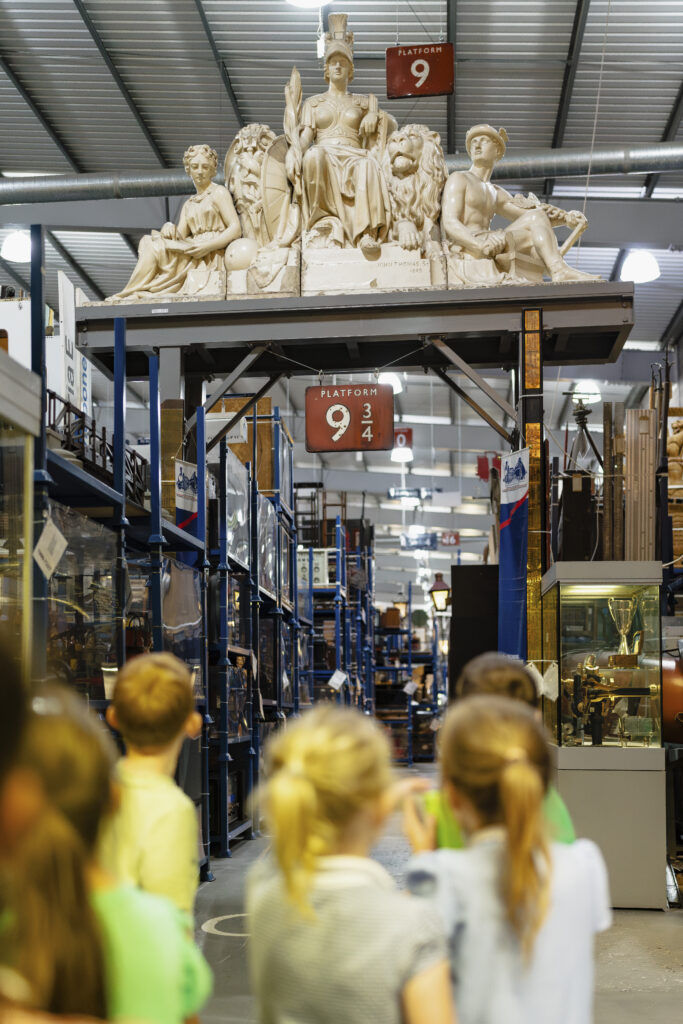
The above interaction illustrates how Ana and other children used movement and gestures to show their understanding of the size and weight of the object. The children attempted to move into the position of Britannia with Supporters, and in doing so clearly experienced the difficulty of positioning themselves in such a way. Ana’s movement influenced her succeeding gestures. When the teacher asked: “How does it feel [to position yourself like the object]?” Ana initially simply replied: “Uhhm.” She did not seem able to verbally communicate her understanding. However, her movement and gestures showed her understanding of the object’s size and weight. Upon further movement, she stated “Phew. The poles [pillars] would be tired, my legs are tired… I think the stone is very heavy,” thus showing a more abstract conceptualisation of the weight of the object’s material. Ana’s movement and gestures provided a ‘toolkit’ for her to communicate her understanding non-verbally, and to then form a verbal abstraction. Through movement and gestures Ana was able to communicate what she knew about the object’s weight and material. Ana was able to link the object to her prior understanding and knowledge, and express her understanding of the object without the use of ‘science’ vocabulary. The movement and gestures that were initiated by the ‘move’ prompts shaped Ana’s and other children’s understanding of objects by providing a link from their physical action to verbal abstraction.
‘Wonder’ prompts extend learning
The ‘wonder’ prompts were successful in encouraging young children to build on and extend their learning about objects beyond the gallery. The prompts supported children to consider verbally how the objects relate to their everyday lives. Most adults used the ‘wonder’ prompts following their children’s engagement in movement and gestures. Often adults used the prompts to prolong the experiences at the relevant objects and keep children from disengaging and wandering off after their use of the ‘move’ prompts. Children were keen to answer the ‘wonder’ questions, with there often being several children in a group volunteering to speak. Children’s responses to the prompts almost always centred on their everyday lives. In particular, children’s responses often focused on how objects might be of interest to people not present in the museum, such as their siblings and parents. Children therefore actively linked their experiences with objects to people beyond the museums. This indicates that the ‘wonder’ prompts support a prolonged learning experience within and beyond the museums. Consider, for example, how a school group of six- and seven-year-olds engaged with the ‘wonder’ prompts at the Silver Fox Locomotive Plaque at NRM (see Vignette 5).
Vignette 5:
The school group had been carefully looking at the Silver Fox Locomotive Plaque and several children had ‘moved like a fox’, such as by making claw grips with their hands. The teacher used the ‘wonder’ prompts to ask children: “What would you tell someone who isn’t here about the fox?” Several children rapidly put their hands up. Six-year-old William mentioned wanting to tell his father about the Silver Fox Locomotive Plaque. William noted: “My dad and I saw a fox in the park. It was eating something and it was very fast and when it saw us it ran off. It was brown coloured, not silver, because it was a real fox. I’d like to tell my dad about this fox on the train.” Several other children chimed in that they had also seen foxes in their local areas, and that they would also like to tell their families that they had seen a silver fox that was part of a train at the Museum.
There is extensive research evidencing the importance of building bridges between children’s experiences in museums and their everyday lives. Such bridges make museum content, including objects, accessible and relevant to children by bringing the content into the realm of children’s direct understanding. Content is then no longer perceived as purely abstract and unfamiliar, but rather as comprehensible and interesting (Falk and Dierking, 2007). In addition, connecting museum content to children’s everyday lives is often associated with longer-term exposure to and interaction with ideas presented in museums, which supports learning (Flewitt et al, 2019). The SMG actively aims to extend experiences in its museums by making the experiences last longer than the activities in the museums themselves. This includes the SMG encouraging further discussion and engagement with museum content and activities at home (Science Museum Group, 2017). The research presented here shows how the Exploration Cubes resource supports this aim by successfully prompting young children to connect their experiences around objects in the museum to their everyday lives.
Creating connections between museum content and everyday lives is particularly relevant for children and adults with low science capital. This is because children and adults with low science capital generally have fewer existing reference points, such as prior experiences in science spaces or specialist science knowledge, that they can use to connect museum content to their lives (Haywood and Moussouri, 2017). The ‘wonder’ prompts provide such a connection between objects and children’s everyday lives by encouraging children to build on their movement and gestures, and reflect on what they themselves find interesting in relation to the object, as well as what their families and friends would find interesting. These activities do not require specific prior understanding or experiences, and demonstrated to the children in this research that science, objects and the museums are relevant for them and people like them. In interviews with children after their use of Exploration Cubes, they often noted that they would like to visit with their families or show their families some of the objects. For example, one seven-year-old who visited NRM as part of a school group noted: “My sister would find this [the Cheeseburger Packaging] funny too. I’d like to show it to her here. I’ll tell my mum too. She will laugh.” These connections between the objects, children’s experiences with the objects in the museum, and children’s considerations of how people familiar to them would perceive the objects are likely to support a longer-term learning process. The ‘wonder’ prompts encourage children to communicate about the object in ways directly connected to their everyday lives and in ways that support communication about the object following museum visits.
Conclusion
The findings from this research show that a simple resource can support young children with low science capital to engage with objects in science museums. The objects that this research focused on include objects that were unfamiliar to the children and their accompanying adults, such as the Condensing Tube and Spinning Mule. Children and their accompanying adults enjoyed using the resource, and children showed consistent signs of engagement and learning when using the ‘see’, ‘move’ and ‘wonder’ prompts. The resource provided for playful interactions and encouraged children to use movement and gestures that supported immediate, and likely continued, learning from objects. In doing so children were using observation skills, curiosity and questioning, teamwork and discussion, all of which are recognised as important ‘science’ skills (Campbell and Howitt, 2021). Children’s use of movement and gestures also allowed them to communicate their ideas and understanding without having to rely on pre-existing confidence in science or specific ‘science’ vocabulary or knowledge. Children’s understanding of objects that is based on their lived and felt experiences could be a gateway towards the further development of ‘science’ skills and vocabulary, an appreciation of science, and an enduring perception that science is for them and people like them.
These findings have practical implications for museums, particularly for science museums exhibiting objects. Object engagement and learning for young children with low science capital can be supported through playful body-based experiences. Exploration Cubes are simple to produce, and school groups can use the resource as part of a self-guided visit with minimal instruction by museum staff. Science museums can use these findings by employing movement and gestures as an interpretive approach to create a more inclusive environment, and to actively promote participation for under-represented groups, such as young children with low science capital.
The research presented in this paper is theoretically significant. It demonstrates the value of embodied cognition theory as a lens to support object engagement and learning in science museums for young children with low science capital. The ‘move’ prompts were successful in encouraging young children to engage with and learn from objects, even unfamiliar objects, without them requiring specific prior knowledge or understanding. These findings demonstrate novel ways to theorise on early years science learning in museums. A focus on body-based experiences can provide links between children’s lived and felt experiences and science objects. Young children’s object engagement, learning and communication of learning can be viewed as grounded in body-based experiences. These findings extend the importance of embodied cognition theory to understand and support young children’s learning in science museums (Manches and Mitchell, 2023). The findings demonstrate that bodily movement and gestures are significant for cognitive processes not only at interactive exhibits, but also at objects.
The current research also demonstrates the value of embodied cognition theory as a lens to actively include and welcome children with low science capital to museums. This is important to support museums in their mission to increase diversity and inclusion, and to ensure that museums are recognised and valued as a place for everyone. The research presented here shows how body-based experiences made objects meaningful to young children with low science capital. Body-based experiences provided many opportunities for connections between encountered objects and prior understanding and interests. Young children were able to learn from objects and communicate this learning without the need for specific vocabulary or specific instruction by adults with high science capital. The body-based experiences documented in this research provide an important foundation for continued science engagement and learning, and a perception that science is accessible, interesting and relevant – attributes that will build young children’s science capital.
Acknowledgments
The research was funded by the Helen Hamlyn Trust, an independent grant-making trust that funds innovative projects aiming to achieve lasting change and improve quality of life. The author would like to thank Karen Davies and Rabea Schwarzmann who provided invaluable contributions to shape this paper. The author would also like to express her sincere thanks to Patrick Scales and Hannah-Rose Ford Tomlinson who carried out the research.



